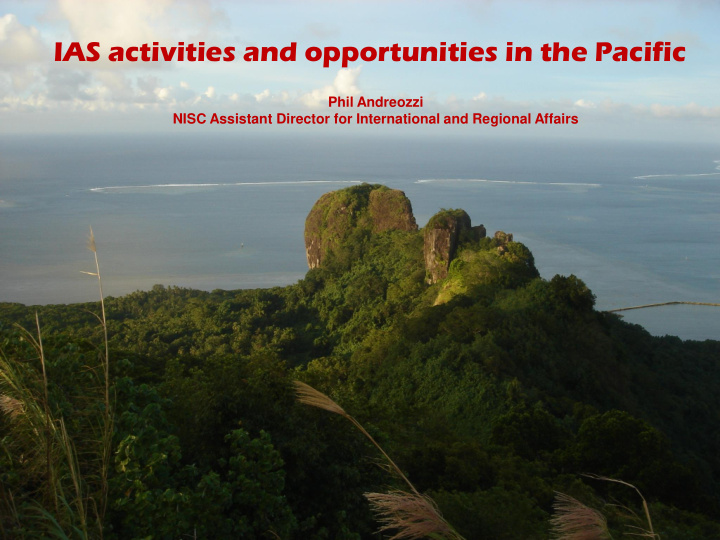



IAS activities and opportunities in the Pacific Phil Andreozzi NISC Assistant Director for International and Regional Affairs
Outline 1. Broad IAS impacts on islands 2. Unique opportunities for success on islands 3. Specific Example from the Pacific 4. Regional Biosecurity Plan for Micronesia and Hawaii 5. Opportunities at upcoming international fora • Pacific Islands Forum – Palau, July 28 – 31 • SIDS – Samoa, September 1 - 4
Broad IAS Impacts on Islands 1. Biodiversity (obviously, but NOT only!) 2. Food Security 3. Ecosystem Resilience (= Climate Change Adaptation) 4. Fresh Water Availability 5. Human Health (Vectors for example) 6. Cultural Resources 7. Protected Areas 8. Trade Options 9. Livelihoods +Tourism All these are critical aspects of Sustainable, Green Development
Unique Opportunities for Success 1. On islands, efforts to prevent, eradicate and control IAS are more likely to be successful, because: • Limited size means eradication efforts more likely to be feasible • Limited ports of entry and no land borders means biosecurity efforts can be strategically concentrated = greater chance of success
Take Home Message Biosecurity, eradication and control efforts on islands are more likely to be successful and have multiple, beneficial effects on other critical island issues. Therefore, funding such efforts is an effective and efficient use of resources.
Brown Treesnake (BTS) Arrived on Guam after WWII Up to 10,000 BTS/square mile Unprecedented ecological damage Logistical constraints > $5 million/year for interdiction on Guam
X X
Why does BTS continue to do so well on Guam ? abundant introduced prey …
BTS Damage Pets and Birds, Bats, Poultry and Lizards Ecological Power Changes Snake Bites Outages
BTS is Just One Threat to Micronesia
Increased Movement of Cargo Regional Biosecurity Plan for Micronesia and Hawaii RBP
Build-up Invasive Species Concerns Massive increase movement of cargo, people, and potentially invasive species Cascading impacts through Region Invasive species will island hop without intervention – biosecurity Regional Concerns Micronesian Chief Executives Letter to DoD Regulatory Concerns Military Concerns
The RBP DOD-Funded $3.7M Comprehensive Plan Covers Entire Region All Ecosystems, Taxa Phase 1: Phase 2: Competitive grant awarded to Risk analyses, port University of Guam assessments UOG, SPC, Landcare NZ, others Recommendations and BMPs Phase 2 Components NISC Coordination Independent scientific review 4 Federal Departments and Strategic Implementation Plan Regional Partners Extensive regional consultation
The Micronesia Biosecurity Plan (MBP) – Phase 1: Comprehensive Plan Covers Entire Region All Ecosystems All Taxa Risk Analyses Unique effort Recommended Actions and BMPs Size and scope Interdepartmental Implementation Strategy Collaboration Proactivity
Phase 1 Details Federal Team: Navy – Funding, Coordination of DoD efforts USDA/APHIS – Terrestrial and Port analyses Smithsonian Institute – Marine Analyses DOI/USGS – Freshwater Analyses NISC – Overall Coordination Regional Collaborators: RISC UOG, Community Colleges SPC State of HI FWS, NOAA NGOs
Phase 1 Processes: Risk Analyses Species, Pathways, Vectors, Ports of Origin Port and Needs Assessments Number of Inspectors, Training level Facilities, Technologies Recommendations and Best Management Practices Identification of Implementation Obstacles NISC provides overall coordination
RBP Phase 2: Competitive grant awarded to University of Guam UOG, SPC, Landcare NZ, others Peer review of draft scientific reports To strengthen and augment the underlying science with input from regional experts making the document truly Micronesian in scope Development of RBP Strategic Implementation Plan Through the RBP recommendations, Existing biosecurity models from around the globe Extensive participatory consultations Chart an effective and realistic path to achieve maximum regional implementation of the RBP.
RBP – Next Stages IMPLEMENTATION! A potential model of effective regional collaboration and proactive biosecurity Applicable tool for invasive species efforts on islands around the world Endorsed by Micronesian Chief Executives (May, 2014)
Upcoming Opportunities • Pacific Islands Forum (July 28 – 31, 2014, Palau) • Side Event on IAS*** Highlight broad impacts, RBP, collaborative efforts • • Language in Communique, Declaration*** • SIDS Meeting (September 1 – 4, 2014, Samoa) • Language in Outcome Document*** Establish separate heading for IAS, highlight broad • impacts GLISPA High Level Side Event • IAS component/announcement*** • ***Not yet confirmed
Questions? Phil Andreozzi National Invasive Species Council Phillip_Andreozzi@ios.doi.gov
Recommend
More recommend